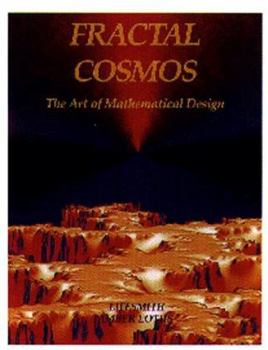Fractal Cosmos: The Art of Mathematical Design
Simple mathematical formulas are transformed into strikingly beautiful computer generated designs. The dynamic interplay between order and chaos is explored in 350 color images in this unique coffee... This description may be from another edition of this product.
Format:Paperback
Language:English
ISBN:1569370648
ISBN13:9781569370643
Release Date:January 1998
Publisher:Amber Lotus
Length:212 Pages
Weight:1.55 lbs.
Dimensions:0.4" x 9.0" x 11.8"
Customer Reviews
5 ratings
Great intro to fractals
Published by Thriftbooks.com User , 15 years ago
There's not a lot of easily understandable information, but WOW! The pictures are great!
math and art
Published by Thriftbooks.com User , 16 years ago
This is a cool book. I tutor middle school students in math and have used this to help them think outside the box. Math can be used to describe everything around us. This book has beautiful color photos of unique calculus graphs.The kids are amazed by the beauty of these designs.
A fractal survey with beauty, intrigue and educational value
Published by Thriftbooks.com User , 23 years ago
I'm really pleased with this book. To me, this is the IDEAL coffee table book on fractals. Chapter one is the obligatory brief history of fractal image generation, including Mandelbrot, population growth, and citing quite a few popular books on the subject. The heart of the book is the eye candy, presented in bright colors on high quality paper, with a bare minimum of mathematical labeling to maximize the "art appreciation" aspect of the viewing. This is divided into 5 chapters of somewhat like families of fractals, with brief but informative introductions. If you want a lot of beautiful fractal images that vary widely - you'll certainly get that here. Chapter 2 gives many images of the Mandelbrot set. Chapter 3 explores various polynomials, powers, roots, and rational expressions. This clearly answered my early layman's question "What about other types of simple equations?" Chapter 4 then goes into exponentials, logarithms, trigonometrics, and various combinations. Chapter 5 then shows 3-d compositions, with many fractal skies, mountains, trees, and landscapes, plus the fractal spheres looking so much like moons or planets. Finally, chapter 6 does some interesting "studies" where you get treated to a page at a time of (6) images with very similar equations, where he alters some variable. Examples: the amount of zooming (up to 169 quintillion - with little loss in image detail), or iterating c by small amounts (like .005 to .01). At this point I thought - very nice book, but I felt a little let down by so little INFORMATION passed along about WHAT these pictures were. The appendices changed all that! Appendix A gives a nice explanation, complete with examples and graphs, of how to generate Julia Set fractal images. Appendix B is a 2 page selected bibliography, including both books and papers. Appendix C lists and briefly explains 20 "Important Formulae for Complex Numbers". Having this would have saved me buying a book about complex numbers when I first discovered fractals, since it implies what the "rules" are. Appendix D is REALLY KEY - for chapters 1-4, it lists nice mathematical data, and in almost all cases this includes: the image type, the equation, the complex constant, the screen parms, the blowup parms, and the maximum number of iterations. Here then, is HOW these beauties were created. For chapter 5, he doesn't list this, and for chapter 6, since they're studies, the detail varies, but is pretty good overall. To me, this takes the book from "very nice" to "awesome" because the layman can now get a better grasp on things and pursue what interests him/her. Finally, unlabeled, but apparently Appendix E in my mind, he provides and index to the images BY EQUATION. A very nice cross reference to those thinking of exploring further in the literature or on their PC's. So the "heavy math" type likely won't find much new here. For the rest of us, who just want some art, some (layman's)meaning/education, or both, aside from parts of "The B
An excellent picture of fractals the CHAOS universe
Published by Thriftbooks.com User , 26 years ago
Jeff, have you read of Dr. John Hubbard from Cornell and his analysis of the Mandelbrot Set? Your results and his analysis are so-ooo intriguing on what fractals promises for the future of mankind!!!! I have a video of his work and it is so fascinating.
Pictures, Pictures, Pictures
Published by Thriftbooks.com User , 26 years ago
A pictorial masterpiece by the best fractal artist of this generation. Your unique Associates ID is: thefractaltransl.





